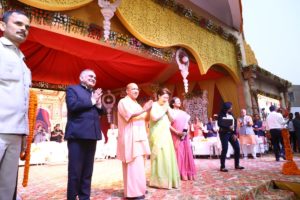
South Korean first lady Kim Jung-sook was the chief guest of the Yogi Adityanath government of Uttar Pradesh during Deepotsva celebrations on November 6, 2018.
- What made Ayodhya’s diwali special was the setting of a new world record by lighting up of over 3 lakh lamps by the banks of the Saryu river. The LED lighting extending from the river bank to the Ram Paedi including the main road and the entrance gate looked festively inviting. The main stream of Ram Paedi flaunted a water show and the lighting on the temples also caught the eye.
Ayodhya connection to South Korea
- Ayodhya has a deep and centuries-old connect with South Korea. A large number of Koreans trace their ancestry to the legendary Queen Queen Suriratna (Heo Hwang-ok) who went from Ayodhya to Korea some 2000 years ago. It was discovered in 2000-01, when the Atal Bihari Vajpayee government was in power that a princess from Ayodhya, the birthplace of Lord Ram, had become a queen of South Korea and started ruling a dynasty there some 2,000 years ago. The lineage is known as Karak dynasty based in Kimhae, a town located near Pusan renamed as Busan, the second-most populous city after the capital Seoul in South Korea. The name of the princess of Ayodhya is mostly known by South Korean sources, where she is named as Heo Hwang-ok. Her original Indian name is believed to have been Suriratna.
- The Kimhae mayor-led delegation proposed to develop Ayodhya as a sister city of Kimhae. It planned to set up a memorial for Queen Huh Hwang-ok. In March 2001, the mayors of Ayodhya and Kimhae signed a Sister City Bond in March 2001.
- A memorial was later built at the bank of Saryu in Ayodhya in the honour of the local princess Suriratna or Korean Queen Heo Hwang-ok.

